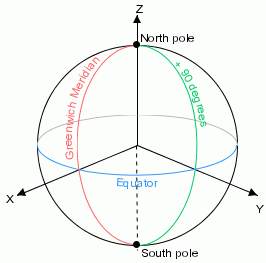Spatial reference system
Spatial Reference Systems (SRS) are a way to link coordinates to a reference, so that objects whose coordinates are expressed in different systems can be displayed in the same manager.
JViews Maps features, or generally speaking graphic objects on maps, are representation of real objects. These map features have to be linked to real-life objects, and this is performed by attaching the attributes to the map features. These attributes can be a location, a time, or any descriptive quality or quantity. For example, you can describe the position of a restaurant either using its coordinates (The restaurant coordinates are 2D28’30’’E, 48D59’05’’N), or a description (The restaurant is at the crossing of X and Y streets, on the same walkway as the cafe). This link between objects and their real life counterpart is called a reference system.
Coordinate system base class
The
JViews Maps supports
Spatial Reference Systems where the reference attributes are coordinates. The abstract class
IlvCoordinateSystem serves as base class for all the coordinate systems.
An IlvCoordinateSystem is defined by:

A optional name.

An array of
IlvUnit defining the units to be used on each axis.

An array of
String defining the name of each axis.

The dimension of the coordinates in use in the system are defined by the number of axes.
There are three major classes of coordinate systems useful for mapping software:

Geocentric Coordinate System
Represents coordinates in a three-axes Cartesian system, whose origin is the center of Earth. This coordinate system is mainly used in
datum conversion.

Geographic Coordinate System
Represents the coordinates specified by angles on an ellipsoid (longitude and latitude). An optional height above the ellipsoid can be used here. For example, this is the standard longitude and latitude given by GPS.

Projected Coordinate System
Represents the coordinates of the Earth on a 2-D surface. There are as many projected
coordinate systems as the number of existing
projections. Projecting coordinates on a 2-D surface is mandatory to display data on a map. As the projection process introduces some errors, not all projections are well suited to represent an area on Earth. For more information, see
Map projections.
Geocentric Coordinate System
The
IlvGeocentricCoordinateSystem class defines a geocentric coordinate system, that is, a three-dimensional Cartesian system. The origin point of this Cartesian system is the center of the Earth.
The axes are perpendicular and defined as follows:

the x-axis lies in the plane containing the equator, and has positive values towards the Greenwich meridian

the y-axis lies also in the plane containing the equator, and is positive towards the longitude 90 degrees east of Greenwich

the z-axis corresponds to the polar axis, and is positive northwards
The geocentric coordinate system
Coordinates in a geocentric coordinate system are expressed in linear units along the axis.
The geocentric coordinate system is mostly used as the base reference system from which geographic and projected coordinates are derived. For example, geodetic datums (horizontal datum) are defined by the shift, rotate and scaling parameters to convert a geocentric coordinate system to a reference geocentric coordinate system (in most cases, the WGS84 datum).
Geographic Coordinate System
The
IlvGeographicCoordinateSystem class defines an ellipsoidal coordinate system where coordinates are specified as latitude and longitude on an ellipsoid, with an optional third coordinate which represents the ellipsoidal height (altitude above the ellipsoid).

Longitude is specified in angular units from the prime meridian of the coordinate system. By convention, coordinates less than 180 degrees east of the prime meridian are positive, coordinates more than -180 degrees west are negative.

Latitude is specified in angular units from the equator. By convention, northward latitudes are positive and southward coordinates are negative.

The convention for representing the poles are longitude set to 0 and latitude set to 90 degrees for the north pole or -90 degrees for the south pole.
The geographic coordinate system
Projected Coordinate System
The geographic and geocentric coordinate systems are not well suited to display maps, since these coordinate systems define map features in a three dimensional world. Before displaying objects, the dimension of coordinates must be reduced to 2. This is performed using map projections (see
Map projections).
A projected coordinate system includes all the parameters that allow you to describe a coordinate system in which each planar coordinate is computed from geographic coordinates using a mathematical function. These include:

The reference geographic coordinate system (the surface modeling the Earth).

The mathematical transformation itself (the projection).
Copyright © 2018, Rogue Wave Software, Inc. All Rights Reserved.

